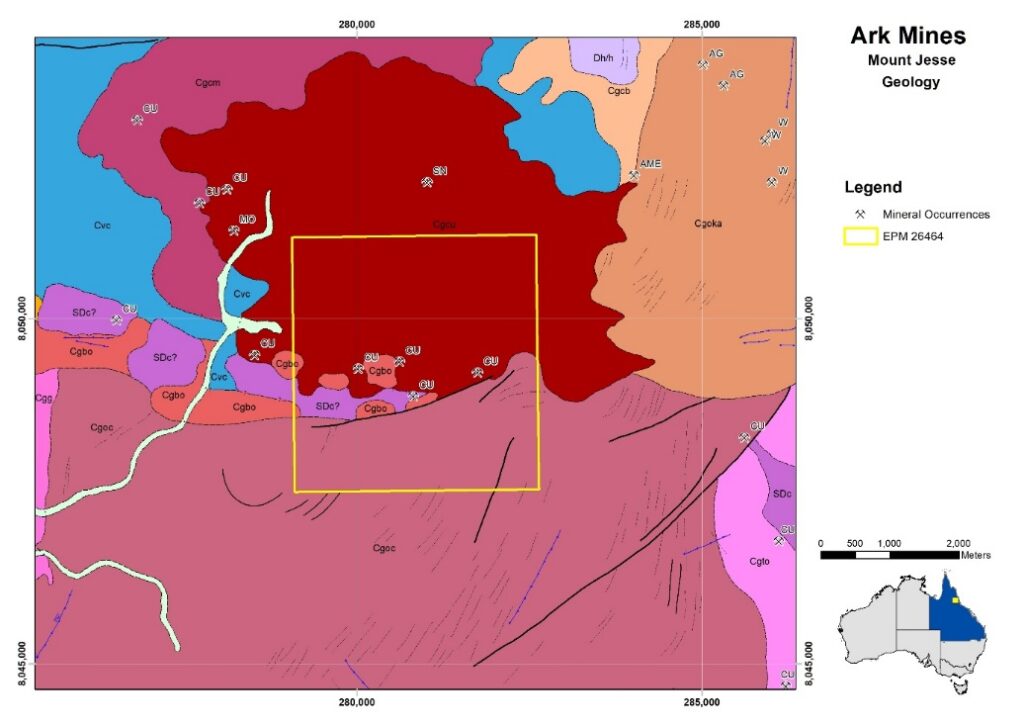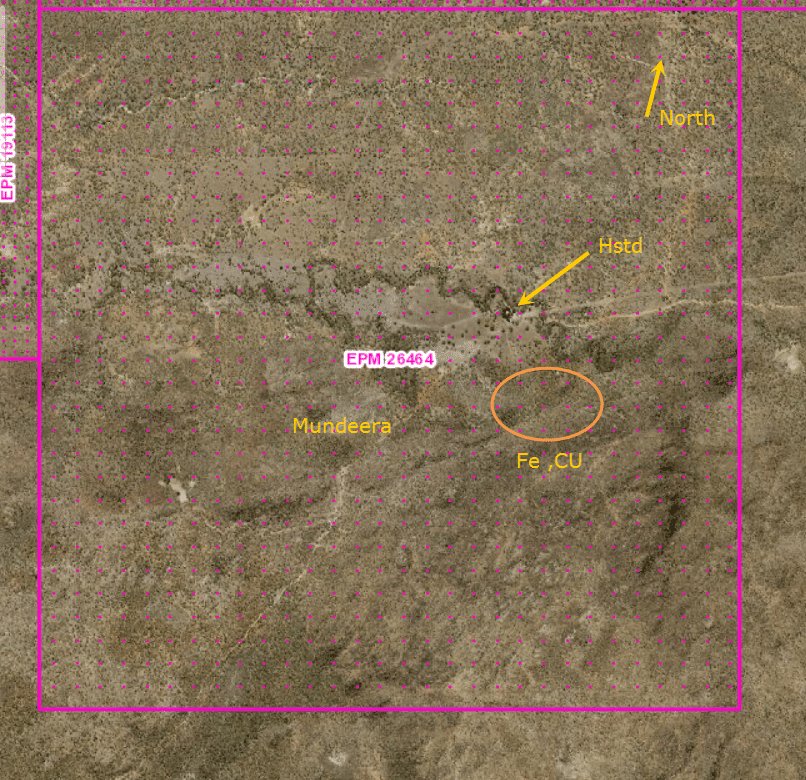Port Access, Nearby Processing Opportunities, 3 Exposed Iron Formations
Project: Mt Jesse
Minerals: Copper, Iron
Status: On Hold
- Introduction
The Mount Jesse Iron with Copper project consists of one exploration permit (EPM 26464), which is located ~176km from Cairns in far-north Queensland.
The project covers three exposed iron formation occurrences, the main one of these occurs layered over fractured granodiorite. The iron formations are massive and homogenous, composed of hematite and magnetite, with strong magnetism. Associated with the Iron is a copper carbonate occurrence (malachite and bornite), in fractured plains.
The project is centered on a copper rich magnetite skarn which potentially is associated with porphyry style mineralisation within a granodiorite. The mineralisation appears to sit above the granite and hug the contacts between the granite and Chillagoe formation as seen at the nearby Mt Lucy deposit. The main area of mineralisation (Mount Cardwell mine) is situated on a small hill and contains zones of strong magnetite (which has been oxidised in places to haematite) with associated copper to a lesser extent. The copper occurs as malachite however it would have originally been a sulphide species that has been oxidised as the malachite predominantly occurs in fractures in the mineralised zones.
2. Local Geology
The local geology is centred on the “Claret Creek ring Structure” which caps the permo – Carboniferous granite which underlies the Jesse project. The ring structures are surrounded by younger late carboniferous granites.
Slivers of Silurian sediments are representative of the remnant country rock, make up a minor portion of the exposed outcrop, the majority of the project is masked by quaternary cover. Hydrothermal fluids have reacted with Silurian limestone / limey sediments to produce magnetite skarn +/- base metal deposits in a number of localities (e.g. Mt Cardwell workings & Jean Prospect).
- Mineralisation
The mineralisation encountered at Jesse consists of iron and copper and occurs in the Chillagoe formation as seen at Mt Lucy and Mt Paddy. The mineralisation is hosted in a skarn deposit with an intrusive granite intruding a sedimentary body (Chillagoe formation) and causing contact metamorphism and depositing iron and in places copper where conditions/ lithology are favourable.
The mineralisation appears to sit above the granite and hug the contacts between the granite and Chillagoe formation as seen at the Mt Lucy deposit. The main area of mineralisation (Mount Cardwell mine) is situated on a small hill and contains zones of strong magnetite (which has been oxidised in places to haematite) with associated copper to a lesser extent. The copper occurs as malachite however it would have originally been a sulphide species that has been oxidised as the malachite predominantly occurs in fractures in the mineralised zones.
Lam et al 1988 lists the Mount Cardwell mine (the main area of mineralisation at Jesse) as producing 1500t of skarn ore at 1% Cu and 10g/t Ag from 1904 to 1908. Company report 64480 by Intermet lists the ore minerals for Mount Cardwell as chalcopyrite and bornite with minor galena, sphalerite and silver ores.
The mineralisation at the Mount Cardwell mine is constrained by granite which is visible on all sides of the small hill. Several other small lenses of mineralisation can be seen to the west of Mount Cardwell where the Chillagoe formation has not been eroded or completely destroyed by the granite intrusives. There is a strong correlation between the copper and the iron mineralisation, however, they do not always occur together and it is likely that the copper is only seen in zones that endured higher temperatures.
Multiple pits (of various sizes and depths), diggings and workings exist on the EPM. The pits and workings west of the Mount Cardwell mine would have most likely been searching for further zones of copper enrichment within the Chillagoe formation. The Chillagoe formation can be seen further to the west of the Mount Cardwell mineralisation however the mineralisation was found to dissipate on the surface after approximately 800m of non-continuous small poddy outcrops.
3. Previous Exploration
The Cardwell copper deposit, which was mined in the late 19th Century comprises small open cuts, two shafts and an adit. These provided access to a skarn style deposit rich in chalcopyrite and bornite with minor galena, sphalerite and silver ores. Work at the mine was relatively short lived, with closure of the mine in the early 20th century due to carriage costs and low metal prices.
The Mt. Cardwell Copper Deposit contains a 90m long magnetite–hematite copper-stained gossan averaging nine metres in width sited above the old workings. Copper has been observed on ground surface in stockwork fracturing and sheeted quartz veins within skarn altered metasediments and fractionated acidic intrusives, as well as on the iron rich gossan. Additional iron +/- copper gossan outcrop has been mapped for some 380m along strike to the west from the old workings.
Historical soil and rock-chip sampling undertaken by InterMet Resources in 2007 encountered copper value up to 20.9%, with an anomalous copper zone identified over an area of 170m by 40m across the summit of a hill within the permit. Additionally, InterMet uncovered gold grades up to 3g/t.
InterMet carried out geophysical surveys at Mount Jesse (including ground-based magnetic and gravity surveys), which highlighted a north-east striking magnetic high which was used to target first pass drilling at the project. InterMet drilled 10 reverse circulation holes between 2008 and 2011, with drilling identifying areas of elevated iron ore (up to 22.65%) and copper (up to 2.11%).
Coincidently circa 3.5 km to the South East of Mt Jesse, Tableland Mining Group are now in the final stages of a significant drill program targeting 8-9MT of iron ore. TMG plan to mine and produce a high-grade iron ore concentrate targeting 66-68% Fe grade.


4. Exploration Potential
Mt Jesse has excellent upside potential given it has a exposed iron knobs clearly sitting within a magnetic high that runs under cover for some hundreds of meters. Further to this Mt Jesse sits 3.5km Northwest of the Tableland Mining Group Iron Ore project, which is being developed as a high grade Iron project with proposed production to commence imminently.
5. Infrastructure
Location:
Mount Jesse EPM 26464 is located approximately 176km from Cairns (164km from Cairns to Mt Garnet and a further 12km from Mt Garnet to Cardwell Station).
Port:
Port Infrastructure in place with a purpose-built ship loader conveyor system.
Mount Jesse is situated approximately 120km from the Mourilyan Harbour (bulk shipping) just south of the North Queensland coastal town of Innisfail.


